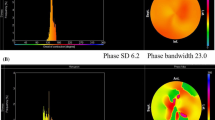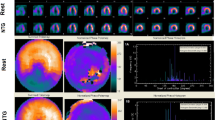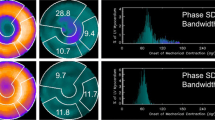Abstract
Thallium-201 reinjection improves detection of hibernating myocardium in about 30%–50% of persisting defects. The main goal of cardiac revascularization techniques is amelioration of clinical symptoms such as angina and dyspnoea; however, improvement in regional and global pump function is an additional and important target. The aim of this study was to investigate whether fill-in in the reinjection study is correlated with improved contractile function after treatment (percutaneous transluminal coronary angioplasty/aortocoronary bypass surgery). We studied 32 patients with coronary heart disease and impaired regional wall motion (RWM). RWM and ejection fraction (EF) were assessed by analysing ventriculographic images using the centreline method (values in standard deviations from mean values found in a healthy control group). Three201T1 single-photon emission tomographic studies (stress, redistribution and reinjection) were performed prior to revascularization and analysed using a bull's-eye scheme. Patients were divided into two groups (group FI-=no fill-in,n=16; group FI+=fill-in,n=16). Fifty-six percent of all patients showed persisting defects, and 56% of these defects showed fill-in after reinjection. Fill-in in our patient group was independent of the size of the persisting defects. After revascularization RWM increased significantly in group FI+ (from −1.9 to 0.0 SD,P<0.001) whereas group FI- showed no significant change (from −1.6 to −1.8 SD). EF increased from −4.3 preoperatively to −2.1 SD postoperatively in group FI+ and did not change significantly in group Fl- (−2.5 to −3.2 SD). The predictive value of reinjection for improvement of RWM was 88%. It is concluded that fill-in in the201Tl reinjection image can predict recovery of RWM and EF after revascularization and should be used in all patients with impaired RWM and persisting defects independent of their extent.
Similar content being viewed by others
References
Takeisbi Y, Tonooka I, Kubota I, et al. Functional recovery of hibernating myocardium after coronary bypass surgery: does it coincide with improvement of perfusion?Am Heart J 1991; 122:665–670.
Tillisch J, Brunken R, Marshall R, et al. Reversibility of cardiac wall-motion abnormalities predicted by positron emission tomography.N Engl J Med 1986; 314: 884–888.
Van den Berg EK, Popma JJ, Dehmer GJ, et al. Reversible segmental left ventricular dysfunction after coronary angioplasty.Circulation 1990; 81: 1210–1216.
Dilsizian V Rocco TP, Freedman NM, et al. Enhanced detection of ischemic but viable myocardium by the reinjection of thallium after stress-redistribution imaging.N Engl J Med 1990; 323: 141–146.
Bartenstein P, Schober O, Hasfeld M, et al. Thallium-201 single photon emission tomography of myocardium: additional information in reinjection studies dependent on collateral circulation.Eur J Nucl Med 1992; 19: 790–795.
Rocco TP, Dilsizian V, McKusick KA, et al. Comparison of thallium redistribution with rest “reinjection” imaging for the detection of viable myocardium.Am J Cardiol 1990; 66: 158–163.
Tamaki N. Ohtani H, Yonekura Y et al. Significance of fill-in after thallium-201 reinjection following delayed imaging: comparison with regional wall motion and angiographic findings.J Nucl Med 1990; 31: 1617–1623.
Ohtani H, Tamaki N, Yonekura Y, et al. Value of thallium-201 reinjection delayed SPELT imaging for predicting reversible ischemia after coronary artery bypass grafting.Am J Cardiol 1990; 66: 394–399.
Schober O, Hasfeld M, Matheja P, et al. Thallium reinjection vs redistribution in severe stenosis of coronary arteries dependent on the collateralization.Eur J Nucl Med 1991; 18: 538.
Braunwald E, Rutherford JD. Reversible ischernic left ventricular dysfunction: evidence for the “hibernating myocardium”.J Am Coll Cardiol 1986; 8: 1467–1470.
Rahimtoola SH. The hibernating myocardium.Am Heart J 1989: 117: 211–221.
Sheehan FH, Schofer J, Mathey DG, et al. Measurement of regional wall motion from biplane contrast ventriculograms: a comparison of the 30 degree right anterior oblique and the 60 degree left anterior oblique projections in patients with acute myocardial infarction.Circulation 1986; 74: 796–804.
Sheehan FH, Bolson EL, Dodge HT, et al. Advantages and applications of the centreline method for characterizing regional ventricular function.Circulation 1986; 74: 293–305.
Tamaki N, Ohtani H, Yonekura Y et al. Significance of fill-in after thallium-201 reinjection following delayed imaging: comparison with regional wall motion and angiographic findings.J Nucl Med 1990; 31: 1617–1623.
Diamond GA, Forrester JS. Analysis of probability as an aid in the clinical diagnosis of coronary artery disease.N Engl J Med 1979; 300: 1350–1358.
Berger BC, Watson D, Burbell LR, et al. Redistribution of thallium at rest and in patients with stable and unstable angina and the effect of coronary bypass surgery.Circulation 1979; 60: 1125–1131.
Gibson RS, Watson DD, Taylor GJ, et al. Prospective assessment of regional myocardial perfusion before and after coronary revascularization surgery by quantitative thallium-201 scintigraphy.J Am Coll Cardiol 1983; 1: 804–815.
Liu P, Kiess MC, Okada RD, et al. The persisting defect on exercise thallium imaging and its fate after myocardial revascularization: Does it represent scar or ischemia?Am Heart J 1985; 119: 996–1001.
Rozanski A, Berman DS, Gray R, et al. Use of thallium-201 redistribution scintigraphy in the preoperative differentiation of reversible and nonreversible myocardial asynergy.Circulation 1981; 64: 936–944.
Brunken R, Schwaiger M, Grover-McKay M, et al. Positron emission tomography detects tissue metabolic activity in myocardial segments with persisting thallium defects.J Am Coll Cardiol 1987; 10: 557–567.
Schelbert X, Buxton D. Insights into coronary artery disease gained from metabolic imaging.Circulation 1988; 78: 496–505.
Tamaki N, Othani H, Yamashita K, et al. Metabolic activity in the areas of new fill-in after thallium-201 reinjection: comparison with positron emission tomography using fluorine-l8-deoxyglucose.J Nucl Med 1991; 32: 673–678.
Author information
Authors and Affiliations
Rights and permissions
About this article
Cite this article
Schäfers, M., Matheja, P., Hasfeld, M. et al. The clinical impact of thallium-201 reinjection for the detection of myocardial hibernation. Eur J Nucl Med 23, 407–413 (1996). https://doi.org/10.1007/BF01247369
Received:
Revised:
Issue Date:
DOI: https://doi.org/10.1007/BF01247369




